
94% of researchers rate our articles as excellent or good
Learn more about the work of our research integrity team to safeguard the quality of each article we publish.
Find out more
ORIGINAL RESEARCH article
Front. Environ. Sci., 07 September 2022
Sec. Drylands
Volume 10 - 2022 | https://doi.org/10.3389/fenvs.2022.846045
This article is part of the Research TopicEcological Restoration in Drylands: Towards Land Degradation NeutralityView all 19 articles
 Amale Macheroum1,2†
Amale Macheroum1,2† Haroun Chenchouni3,4*†
Haroun Chenchouni3,4*†The soil–vegetation relationships are reciprocal and fundamental for terrestrial ecosystem integrity. However, the long-term degradation of vegetation cover alters edaphic conditions, which can lead to degradation of habitats, and obstructs proper ecosystem functioning. This study aimed to assess the effects of the degradation of perennial steppe vegetation due to overgrazing (i.e., continuous and free grazing) on the physicochemical characteristics and soil fertility in the steppe rangelands of Halfa (Macrochloa tenacissima syn. Stipa tenacissima) of semi-arid areas in Algeria. The edaphic parameters of the superficial horizons of degraded steppes and other undegraded steppes were compared in order to suggest adequate strategies for rangeland management and remedy the degradation of vegetation and thereby ensure the sustainability of these agro-pastoral systems. The soil, collected from the surface horizons (A1 and A2) of pedological profiles, was analyzed according to standard methods of soil physicochemical analyses to determine the particle size fractions (clay, silt, and sands), pH, electrical conductivity (EC), total and active CaCO3, organic matter (SOM), organic carbon, total nitrogen, and the C:N ratio. The distribution and variation of soil parameters between horizons and the two types of steppes were examined using generalized linear mixed models and redundancy analysis. Findings of this study revealed that the degradation of steppe vegetation cover by short-term overgrazing did not cause a significant variability in soil physicochemical parameters between degraded and undegraded steppes and the horizons A1 and A2. The sites studied have clayey–silty textures in non-degraded steppes and coarse textures dominated by sands in degraded steppes. The edaphic environment of the Halfa grass steppes was characterized by a calcareous substratum with high carbonate content (total CaCO3 = 36.8–41%, active CaCO3 = 17.5–18.5%), with an alkaline pH (8.09–8.19) and EC averaging 0.99 ± 1.24 dS/m. Soils had low SOM contents (1.42–2.93%), organic carbon (0.82–1.64%), and nitrogen (0.1–0.15%). The strong positive correlations recorded between the fine-size fractions, SOM, total CaCO3, nitrogen, and EC indicated good soil structural stability in undegraded steppes, while the negative correlations between these same variables with sand and pH substantiate the structural degradation of the soil. The negative correlation between C:N ratio and SOM indicated that the rate of SOM mineralization was rapid in semiarid steppes, with a higher fertility state in the undegraded steppe. Our findings suggest and urge to implement a restoration plan against the degradation of semi-arid Halfa steppes in order to avoid the irreversible state of soil and habitat destruction in the future because even the degradation of rangeland plant cover due to livestock overgrazing—in the short term—has not affected the edaphic characteristics of steppe rangelands.
Soil degradation results from the combination of factors which drive the soil to an evolution different from the natural evolution linked to the local climate and vegetation (Osman, 2018; Dragović and Vulević, 2020; Smith et al., 2020). Land degradation is generally directly linked to the action of human activities via, for example, 1) the replacement of the native diversified vegetation (known as climax) by a secondary vegetation, a monoculture in the worst case, which modifies the humus and soil formation processes (Fialho and Zinn, 2014); 2) decrease in the soil organic carbon pool induced by overexploitation of the organic matter in the soil (non-return or insufficient return of the exported matter) and/or its leaching (Joosten, 2015; Garcia et al., 2018); 3) destruction of humus and insoluble clay–humic complexes of the soil due to inappropriate agricultural practices such as plowing which buries and destroys the living upper layers of the soil, or by excessive tillage, i.e., too intensive or too frequent (Baranian Kabir et al., 2017; Garcia et al., 2018); 4) acidification, salinization, and desertification which can be induced or exacerbated not only by climate change but also by irrigation and drainage (Dragović and Vulević, 2020; Smith et al., 2020); 5) water and wind erosions, which are facilitated by plowing, vegetation clearing, and overgrazing, which leaves the soils bare for too long; therefore, they become prone to deconstruction and degradation by the impact of droughts and/or rains which trigger surface runoff and sheet erosion instead of infiltration (Benabderramane and Chenchouni, 2010; Arar and Chenchouni, 2014; Belala et al., 2018); 6) pollution by heavy metals or biocidal substances which harm soil essential organisms (fungi and earthworms) and thus disrupt the cohesion and capillarity of the soil (Singh et al., 2020); and 7) soil compaction, which is one of the most serious and common forms of soil degradation; it induces a sharp drop in the natural porosity of the soil and causes soil asphyxiation. Soil compaction is most often related to agricultural and forestry machinery, but overgrazing and over-frequentation of an environment by humans can contribute locally to vegetation trampling (Osman, 2018). The degradation of a given soil can ideally be assessed by comparisons of physicochemical and biological parameters with identical undegraded soil (Yong-Zhong et al., 2005; Neffar et al., 2013; Fialho and Zinn, 2014; Bouaroudj et al., 2019; Chenchouni et al., 2019).
The arid and semi-arid regions of North Africa are currently experiencing a severe degradation of natural resources (Le Houérou, 2009; Slimani et al., 2010). The region comprises various plant formations including forests, shrublands, matorrals, and steppes, which are experiencing a regression under climatic and anthropogenic influences (Aidoud and Touffet, 1996; Chenchouni, 2010; Kouba et al., 2021). This dual action induced physiognomic and landscape changes which are at the origin of long-term dynamics and major changes in the region’s resources (Le Houérou, 2009; Negm et al., 2020).
With about tenth of the Algerian territory, the steppe rangelands sustain the livelihood of the agro-pastoral population (∼12% of the total population), which depends essentially on the proper functioning and integrity of these ecosystems (Hadeid, 2006; Nedjraoui and Bedrani, 2008; Hamel, 2018). The degradation state of the Algerian steppe rangelands is translated via the decline in natural resources observed in several regions throughout the country (Nedjraoui and Bédrani, 2008; Moulay et al., 2012). Climate changes combined with overgrazing and an increase in the number of livestock are the main sources of steppe vegetation degradation, causing land desertification and serious decline in steppe areas of Macrochloa tenacissima (L.) Kunth (syn. Stipa tenacissima L.) named in Arabic Alfa or Halfa (Macheroum and Kadik, 2015; Merdas et al., 2021). Free grazing with a high number of animals adversely affects the natural resources of these rangelands already weakened by climatic hazards, including severe droughts and intense heatwave events (Nedjraoui and Bédrani, 2008; Belala et al., 2018; Kouba et al., 2021). Already, the productivity and regeneration of the Algerian steppes have reached a critical state of degradation (Martínez-Valderrama et al., 2018), where the degradation islands constantly expand across the considerable diffuse surfaces, whereas in the past, these localized patches of degradation were spatially limited (Kadi-Hanifi, 1998; Macheroum and Kadik, 2015). Steppe degradation was amplified and aggravated by the anarchic clearing and plowing combined with inadequate development of steppe areas and poor grazing management by farmers and pastoralists in the context of aids granted by the state for exploitation of the steppes (Hadeid, 2006). These degradation conditions favor the establishment of plants of low forage value that do not meet the needs of the animal load, but rather this accentuates the pressure of overgrazing on non-degraded areas (Hasnaoui and Bouazza, 2015; Merdas et al., 2021).
In steppe ecosystems, soil physicochemical properties play a key role in soil–vegetation relationships because the distribution of the vegetation is closely linked to the characteristics of the abiotic environment, especially the edaphic and climatic parameters (Chenchouni, 2017; Bezzalla et al., 2019) and also biotic interactions (Bansal and Sheley, 2016; Merdas et al., 2021) including livestock grazing (Liu et al., 2020), which also has various feedback influences on the soil itself (Haynes and Williams, 1992; Dormaar and Willms, 1998; Yong-Zhong et al., 2005; Cheng et al., 2016; Ye et al., 2016). Several studies have extensively investigated environmental-related problems of North African steppes in terms of soil erosion, desertification, droughts, plant community diversity, and vegetation cover dynamics in relation to livestock grazing and various land managements (Aidoud and Touffet, 1996; Benabderramane and Chenchouni, 2010; Belala et al., 2018). However, the situation of the soils of North African steppe ecosystems, and in particular those of Algeria, is poorly understood and very little studied in the context of different temporal scales of land degradation due to grazing pressures inducing plant cover changes, which are constantly increasing in order to meet growing socioeconomic needs. In North Africa, studies that have investigated the fate of soil properties in degraded steppes are very rare (Aidoud et al., 1999; Jeddi and Chaieb, 2010; Amghar et al., 2012; Neffar et al., 2013; Hasnaoui and Bouazza, 2015; Neffar et al., 2022). The scientific questions addressed in this study are as follows: 1) does the degradation of steppe vegetation induce degradation or significant change in soil characteristics? 2) Is this change dependent on the time during which the steppe was subjected to degradation? 3) In response to land degradation, will steppe soil parameters react in the same way at the different horizons? 4) How do soil parameters interact with each other for different degradation conditions of semi-arid steppes (degraded vs. undegraded)? Thus, this study aimed to determine and compare the variations in edaphic properties in different soil horizons and between degraded and undegraded steppes of Halfa (M. tenacissima) in semi-arid areas of Algeria. Under degradation conditions of the steppe plant cover, it is expected that a decrease in soil fertility is observed and a depletion of soil organic matter (SOM), which determines the amount of soil organic carbon (SOC), phosphorus and nitrogen and therefore the C:N:P ratio that was taken as a reliable indicator of soil fertility (Boudjabi and Chenchouni., 2021; (Boudjabi and Chenchouni., 2022). Nevertheless, while the above-ground biomass and litterfall are expected to experience a significant and rapid decrease in degraded rangelands (Snyman, 2005), the effect of vegetation degradation on soil carbon and nitrogen stock dynamics is a slow process where tangible changes are expected to be observed at long-term (Chapin et al., 2009; Chenchouni and Neffar, 2022). Therefore, the current study seeks to first determine whether short-term degradation could induce significant deterioration of soil conditions, and subsequently, it aims to suggest recommendations for restoring the habitat to a state with balanced and well-functional soil.
The study area “Region of Tebessa” is located in the highlands of northeast Algeria (Figure 1). Included between 35°29′N and 35°40′N latitudes and 07°35′E and 08°23′E longitudes, the region involves agro-sylvo-pastoral systems where agricultural lands occupy 56%, forests and shrubs 26%, and steppe rangelands 11% of the studied area (Macheroum and Kadik, 2015). The rainfall data for the period 1972–2016 (Tebessa weather station) showed that the rainiest month was September (40.9 mm) and the driest month was July (14.9 mm). The seasonal regime showed a maximum in spring (112.96 mm) and a minimum in summer (43.21 mm). Annual precipitation was highly variable (mean = 372 mm/year), with a coefficient of variation of 27.62%. This interannual variation is a characteristic of arid climates, but it is here slightly below the level given for the arid zones of North Africa (Le Houérou, 2001, 2009). The mean of minimum temperature of the coldest month (January) was 1.7°C, and the maximum temperature of the hottest month was 35°C, recorded in July. The study area has a Mediterranean semi-arid bioclimate with cool winter. The Emberger’s pluviothermal aridity index (Q2) was estimated to be 38.85. According to the Köppen climate classification (Supplementary Appendix S1), the region falls under a cold semi-arid (steppe) climate (Köppen code: BSk). Two seasons marked the climate each year, a cold and humid season (November‒April) and the second is hot and dry (May‒October). The impact of drought is accentuated by frequent events of the sirocco (southerly hot and dry wind) which occur in late spring and summer. With haplic calcisols (Boudjabi and Chenchouni, 2022), three different steppe regions dominated by Halfa grass were studied in the Tebessa region. Within each of these regions, the soil of two types of steppes, i.e., degraded recently ( < 2,3 years) and undegraded (Figure 2) was sampled. The various characteristics of degraded and undegraded steppes studied and sampling sites are listed in Table 1.
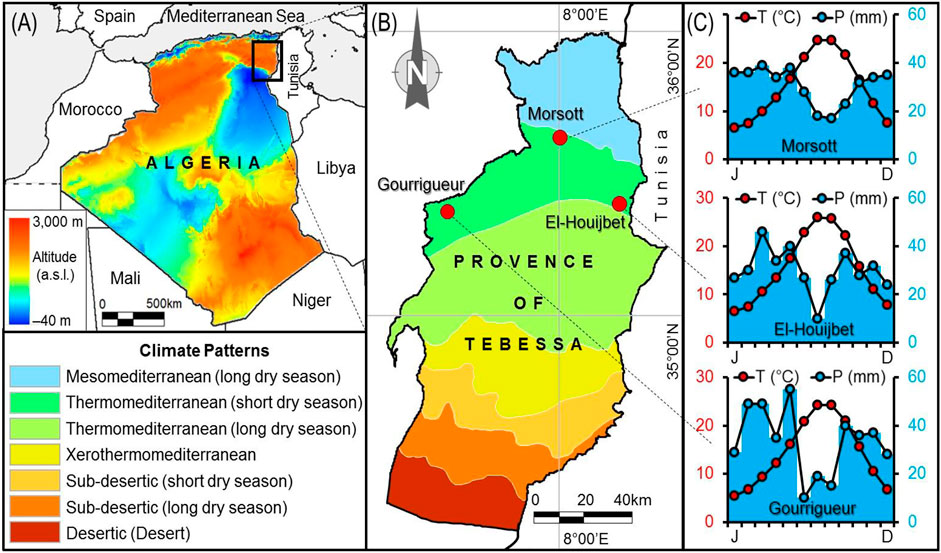
FIGURE 1. (A) Altitude map of Algeria in North Africa, (B) map of climate zones of the Province of Tebessa, northeastern Algeria, displaying the geographic locations of the steppe rangelands studied, (C) ombrothermic diagrams of Gaussen and Bagnouls of the three study sites in Tebessa, where mean temperature (T in °C) and precipitation (P in mm) are monthly averages.
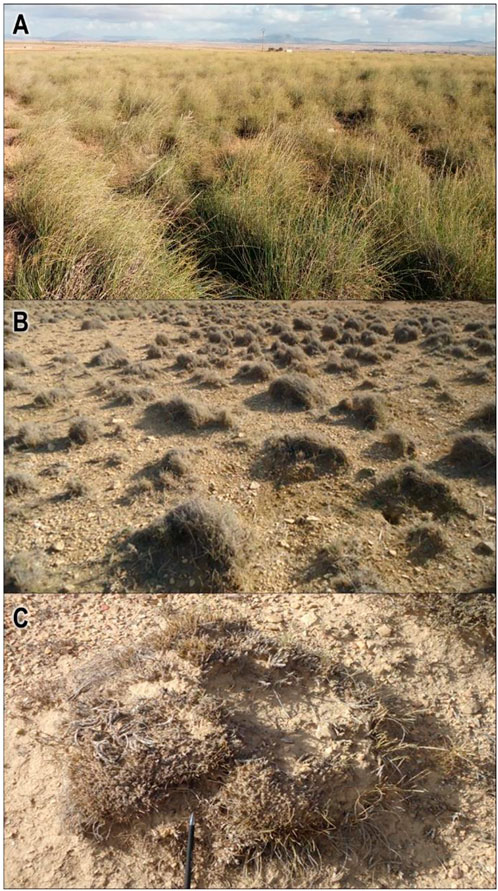
FIGURE 2. Photographs of semi-arid steppes rangelands of Macrochloa tenacissima syn. Stipa tenacissima in northeastern Algeria. (A) Undegraded steppe with healthy and dense Halfa vegetation, (B) degraded steppe rangeland due to overgrazing by sheep and goats, (C) a close-up view showing the morphological aspect of a tuft of Halfa containing necromass of roots and small-size living leaves lasting after livestock overgrazing.
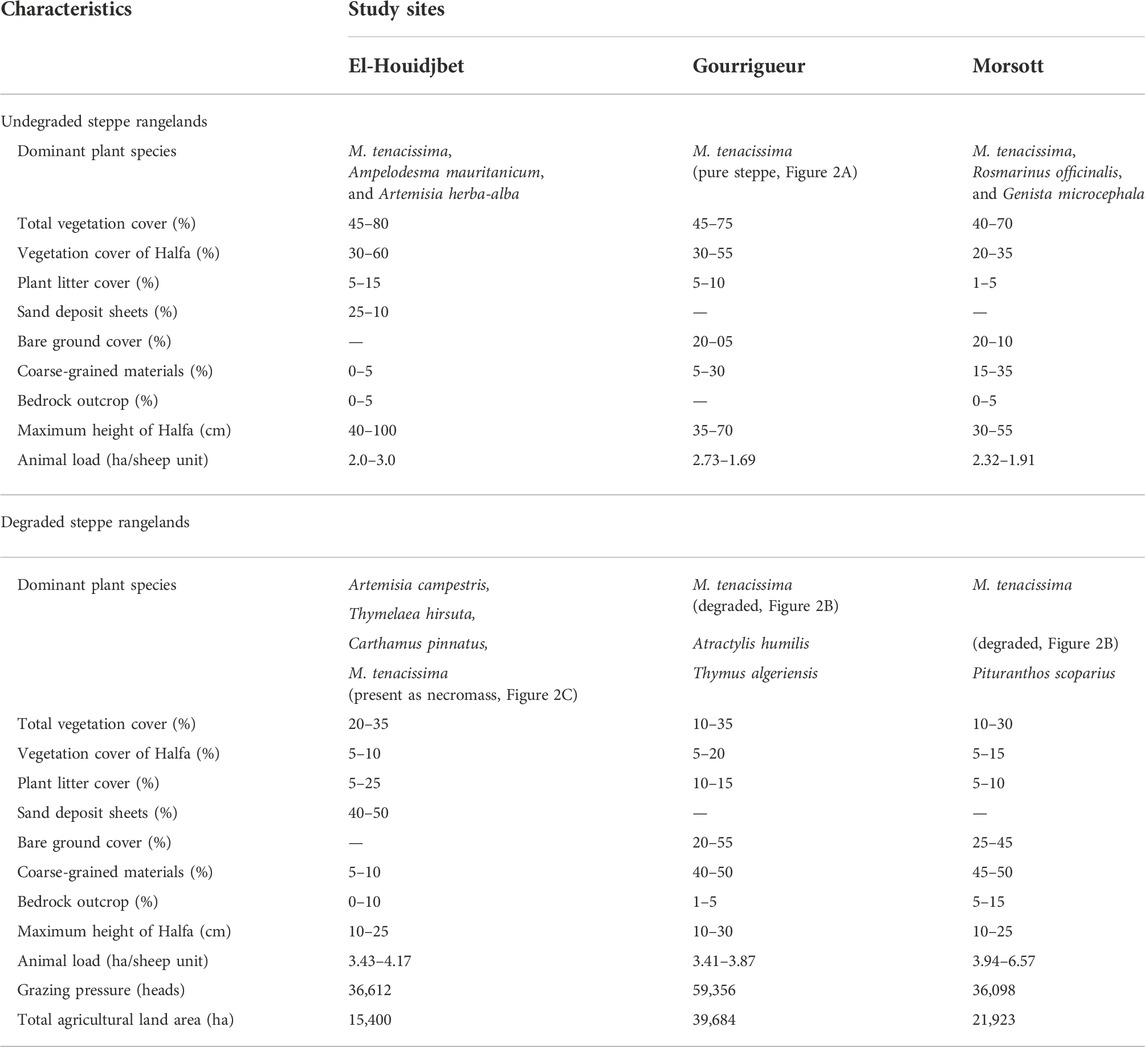
TABLE 1. Characteristics of degraded and undegraded steppes in sampling sites of Halfa grass (Macrochloa tenacissima syn. Stipa tenacissima) rangelands in northeastern Algeria.
Site 1: El-Houidjbet (35°17′50″N, 08°17′36″E, altitude: 1,000–1,200 m a.s.l.) is located 23 km south-east of Tebessa City. The relief has a moderate topography with varied slopes (0–12%), and is characterized by limestone and hard dolomitic geological substrates (74.1% of the total surface), alluvium and sands (24%), and marls (1.9%) (HCDS-BNEDER, 2007). Climatically, the average annual precipitation rate was 342 mm with 54 days of rain, where March was the rainiest month (43 mm) and June was the driest (10 mm). The minimum temperature (6.5 ± 0.8°C) was recorded in January, while July was the hottest month with a mean maximum temperature of 35 ± 3.5°C (Supplementary Appendix S2). The climate was cool (lower zone) semi-arid, according to the Emberger classification (Q2 = 35.2) with De Martonne aridity index = 14 and a continentality index = 36.9 (Supplementary Appendix S1).
Site 2: Gourigueur (35°25′22″N, 07°35′36″E, altitude: 863–1456 m m a.s.l.) is located 47 km north-west of Tebessa. Geomorphologically, the site includes gullied slopes (average slope ∼10–25%), glacis dominated by limestone and hard dolomite substrates (54.5% of the surface), alluvium, sands, and limestone crust (22.12%), and marl (11.05%) (HCDS-BNEDER, 2007). The average annual rainfall was 377 mm (63 rainy days), the large amount of rainfall was recorded during May (50 mm), and the lowest was recorded in June (10 mm); the lowest temperature was recorded in January (5.5 ± 2°C), and it reached a maximum of 35 ± 2°C in July (Supplementary Appendix S2). This region is located at the upper zone of cool semi-arid bioclimate (Q2 = 38.85), with De Martonne aridity index = 16 and a continentality index = 34.7 (Supplementary Appendix S1). At the landscape scale, a homogeneous structure characterized the steppe surface (4,520 ha); however, it presented locally a discontinuity due to the presence of scattered patches of cultivated and/or degraded areas.
Site 3: Morsott (35°40′06″N, 08°00′26″E, altitude: 600–1,000 m a.s.l.) is located 38 km north of Tebessa. The geomorphological forms corresponded to low to medium slopes (5–20%), glacis (0–4% of the surface), and marl‒limestone geological substratum (63.24%) (HCDS-BNEDER, 2007). Climatically, annual precipitation averaged 351 mm recorded on 59 days of rain. The highest amount of rain was recorded in March (37 mm) and the lowest in July and August (17 mm). The mean minimum temperature was recorded in January (6.5 ± 2.2°C), while the maximum was measured in July (35 ± 3.1°C). This sampling site falls within the lower zone of the cool semi-arid bioclimate (Q2 = 36.17), with De Martonne aridity index = 15 and a continentality index = 32.6 (Supplementary Appendix S1 and Supplementary Appendix S2).
In this study, the analysis of soil characteristics in the sampling sites aimed at demonstrating whether the degradation of the Halfa vegetation cover in the short term is accompanied by serious modifications in soil essential components. According to the study by Kadi-Hanifi (1998), each phytoecological study should be completed by the analysis of edaphic variables and vice versa. Therefore, this study focused on the comparison of soil physicochemical characteristics between degraded and undegraded Halfa steppes in each of the three sampling sites. The soil sampling was carried out during the fall of 2016. Using a pickaxe, three soil profiles in each type of steppe (degraded vs. undegraded, Figure 2) were dug vertically to a maximum depth of 1 m, and six soil samples with three replicates were recovered from each sampling site. The thickness of the surficial soft layers of each profile was determined, and then a soil sample was taken from each of the horizons A1 and A2 of each type of steppe. The distinction between the A1 and A2 horizons was mainly based on color, layer thickness, and morphological appearance. The soil samples were collected in a paper bag labeled with the sample information. The samples were dried in open air for a week. After desiccation, the soil was sieved using a sieve with a 2-mm mesh to separate the coarse elements from the fine earth, which was used for soil analyses following standard soil analysis techniques (Mathieu and Pieltain, 2003; Baize, 2018).
All soil physicochemical analyses were performed using fine earth (Ø < 2 mm). For each soil sample, the particle size distribution was determined after the destruction of soil organic matter (SOM) using an energetic oxidant (oxygen water), and then the mineral particles were dispersed using an alkaline dispersant (sodium hexametaphosphate). Coarse-size particles larger than 0.05 mm in diameter were separated by sieving, and medium-size and fine-size particles were measured by sedimentation rate. The type of soil texture was determined following the USDA textural soil classification (Duchaufour, 1997). Soil pH (pHw) was measured in a soil/solution suspension prepared with distilled water with a ratio of 1/5 (s/w) by the electrometric method using a pH meter (Mathieu and Pieltain, 2003). The electrical conductivity (EC) was estimated with a conductivity meter in the soil extract prepared by stirring a mixture of sol/water (ratio s/w = 1/5) for 15 min (Mathieu and Pieltain, 2003). Total carbonate calcium equivalent (TCCE) was calculated using the Bernard calcimeter method (Baize, 2018). The Drouineau–Galet’s method (Mathieu and Pieltain, 2003) was used to determine the active carbonate calcium equivalent (ACCE), which was neutralized with oxalates. Organic matter was quantified from SOC content (i.e., SOM = SOC×1.724), which was evaluated using the method of Anne (Duchaufour, 1997). Total nitrogen was determined following the Kjeldahl method (Mathieu and Pieltain, 2003; Baize, 2018). The C:N stoichiometry of soil was appraised, using the ratio of SOC to nitrogen content as a good indicator of nitrogen and humus richness (Duchaufour, 1997; Mehalaine and Chenchouni, 2022).
Soil physicochemical parameters were expressed as means and standard deviations, whereas descriptive statistics of the data were plotted for soil horizons A1 and A2 for both degraded and undegraded steppe rangelands. The coefficient of variation (CV) was computed to measure the dispersion of the frequency distribution for soil grain fractions (clay, silt, and sand). The variation of each soil parameter between soil horizons and rangeland steppe conditions (degraded and undegraded) was tested using generalized linear mixed models (GLMMs). In each model, steppe conditions, soil horizons, and their interaction were the fixed effects, whereas the three sampling sites (Figure 1) were considered random effects. Linear interrelationships between all soil physicochemical parameters were examined separately for degraded and undegraded steppes using Pearson’s correlation tests. The results of correlations (Pearson coefficients and p-values) were mapped in the form of a correlation matrix. The Mantel test was applied between the two correlation matrices in order to demonstrate how the pattern of soil parameter interactions was similar between degraded and undegraded steppes. The distribution of the Pearson coefficient between two matrices and p-value were estimated from 10,000 permutations. Statistical significance of all tests was set at p < 0.05. In order to visualize the correlative relations between soil fertility indicators (i.e., organic carbon, total nitrogen, and C:N ratio) and the rest of soil physicochemical parameters (i.e., clay, silt, sand, pH, EC, ACCE, and TCCE) at each soil horizon and for degraded and undegraded steppes, a redundancy analysis (RDA) was implemented. All statistical analyses and graphic plotting of the current study were carried out using the packages {nlme}, {ggplot2}, {vegan}, and {corrplot} of the free statistical software R (R Core Team, 2020).
The texture of soil samples in degraded steppes ranged from medium-size types (silty clay loam, clay loam, and loam) to coarse-grain type (i.e., loamy sand) compared with the soil texture observed in undegraded steppes, where the soils in the north of the study area at Morsott and north-west at Gourigueur had medium-size (i.e., clay loam) and moderately fine textures (i.e., silty clay), respectively. The soils in the southeast of the study area at El-Houidjbet were coarse and included sand, loamy sand, and sandy loam (Figure 3). For the same sampling site and the same steppe type (degraded vs. undegraded), there was no vertical variation in the distribution of grain size between the horizons (degraded or undegraded).
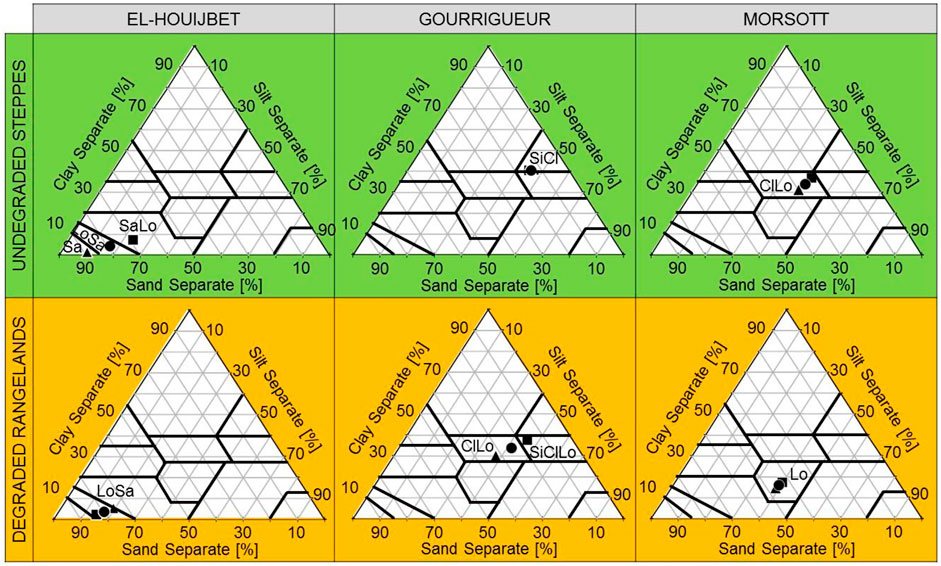
FIGURE 3. Soil textural triangles (following the USDA classification) of study sites for degraded and undegraded steppe rangelands in northeastern Algeria. Symbols plotted within each triangle represent soil samples of horizon A1 (▲), horizon A2 (■), and the average (●). (ClLo: clay loam, Lo: loam, LoSa: loamy sand, Sa: sand, SaLo: sandy loam, SiCl: silty clay, and SiClLo: silty clay loam).
The content of the clay fraction was higher in the undegraded steppes for both A1 and A2 horizons with 24.5 ± 20.5% (mean ± standard deviation) and 28.1 ± 18.2%, respectively, than in the degraded steppes where clay averaged 16.7 ± 12.5% and 19.1 ± 17.6%, respectively (Figure 4). The level of the silt fraction was relatively unvarying between the soil horizons of the two types of steppes; it ranged from 31.8 ± 10.9% to 36.5 ± 11.2%. Sand levels in degraded steppes (51.5 ± 22%) were significantly higher than those of undegraded ranges (43.9 ± 40%), especially at the A1 horizon compared with A2 (47.6 ± 33.5%). The large values of the coefficients of variation (CVs) indicated a high heterogeneity in the spatial distribution of the particle size fractions of the texture of the studied soils. According to CV, the distribution of particle fractions was more unbalanced in the A1 horizon of undegraded steppes than in the A2 horizon of degraded steppes.
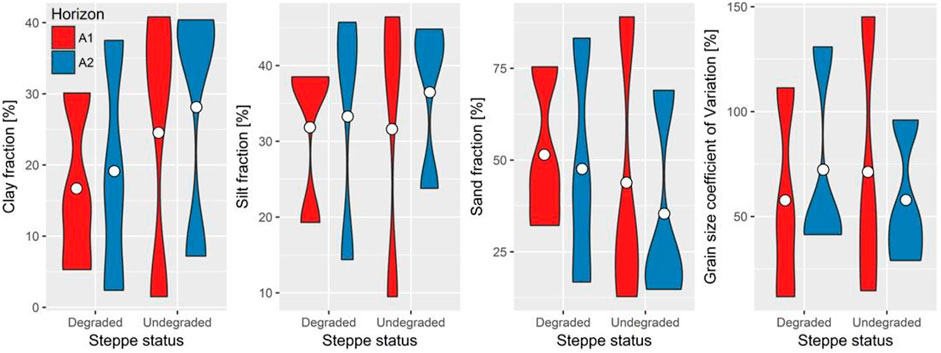
FIGURE 4. Violin plots displaying the range of soil grain fractions (clay, silt, and sand) and the coefficient of variation measured at soil horizons A1 and A2 for degraded and undegraded steppe rangelands of the Halfa grass (Macrochloa tenacissima) in northeastern Algeria. Solid white circles represent the mean of observed data.
Figure 5 illustrates the variation of the soil physicochemical parameters of the A1 and A2 horizons for degraded and undegraded steppes. The pH values measured at the two types of steppes (degraded vs. undegraded) showed some stability and indicated that the soils where Halfa exists were alkaline, with pH ranging from 8.09 ± 0.21 to 8.19 ± 0.4 (mean ± standard deviation). Soil EC indicates that the study area had—generally— low saline soil in all the steppes studied, while the highest values were recorded in the undegraded sites on the A2 horizon (EC = 0.99 ± 1.24 dS/m). Regardless of steppe degradation status, the levels of TCCE, ranging from 36.8 ± 30.2% to 41 ± 33%, revealed that the analyzed soils were moderately rich in CaCO3. The content of active CaCO3 was almost stable in all soil samples. It fluctuated between 17.5 ± 2.1% and 18.5 ± 0.3%. The analyzed soils were considered rich in ACCE. Because of the vegetation heterogeneity between the degraded and undegraded steppes, the content of SOC was moderately low throughout the study area, where the lowest (0.82 ± 0.13%) and highest (1.64 ± 1.14%) values were observed in the A2 and A1 horizons, respectively, of the undegraded steppes. Overall, the nitrogen content was very low in the steppe rangelands sampled as it varied between 0.1 ± 0.01% and 0.15 ± 0.06%. However, the highest values were recorded in the A1 horizon for both degraded (0.15 ± 0.06%) and undegraded (0.13 ± 0.07%) steppes. The C:N ratio revealed that the SOM decomposition was slower in the A2 horizon of undegraded steppes (12 ± 3%) and the A1 horizon of degraded steppes (10 ± 4%) when compared to the moderately fast SOM decomposition in the rest of soil horizons of sampled steppes.
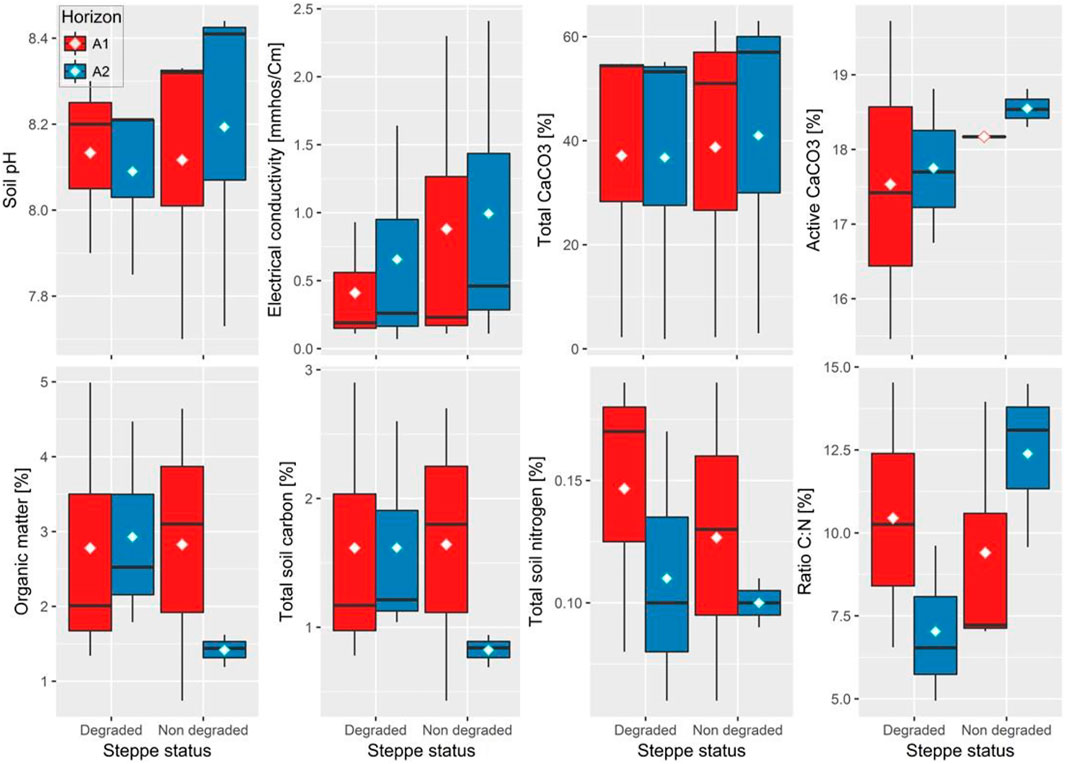
FIGURE 5. Boxplots showing the variation of soil physicochemical parameters measured at horizons A1 and A2 for degraded and non-degraded steppe rangelands of the Halfa grass (Macrochloa tenacissima) in northeastern Algeria. White diamonds within boxplots represent the mean of observed data.
The GLMMs testing the variation of soil parameters between degraded and undegraded steppes at the soil horizons A1 and A2 revealed significant differences in the clay fraction (p = 0.011) and sand fraction (p = 0.042) between degraded and undegraded steppes (Table 2). However, there was no significant variation (p = 0.093–0.972) in the rest of the soil parameters between the different soil horizons, steppe degradation status, and for horizons in interaction with steppe degradation conditions.
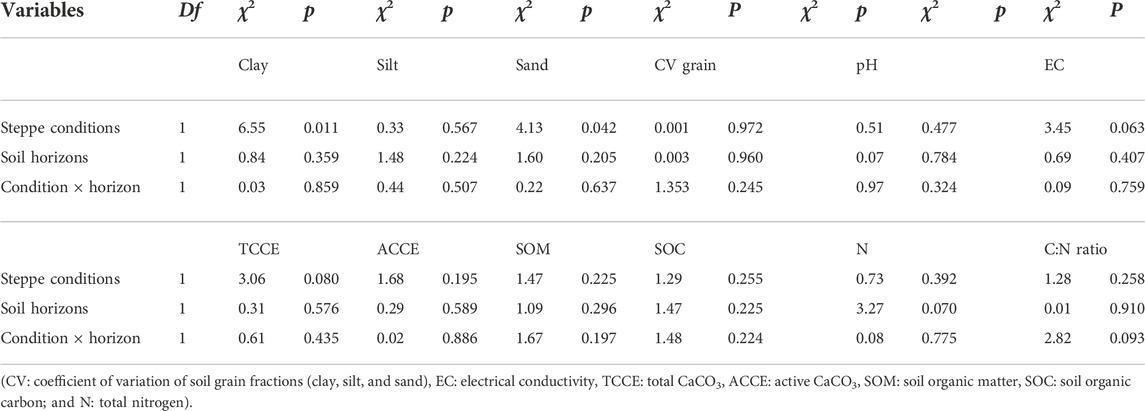
TABLE 2. Generalized linear mixed-effect models (GLMMs) testing the variation of soil physicochemical parameters between soil horizons (A1 and A2) and habitat conditions “degraded and undegraded” of steppe rangelands of Halfa grass (Macrochloa tenacissima) in northeastern Algeria.
In general, the soil parameters were poorly correlated with each other throughout the study area (Table 3). The significant positive correlations found in the two steppe cases included the following: clay‒silt, silt‒TCCE, and SOM‒SOC, whereas significant negative correlations were observed between sand (clay, silt, and TCCE) and pH‒EC. Soil parameters that showed strong positive correlations in degraded steppes were clay‒EC (r = 0.93, p = 0.006), sand‒pH (r = 0.82, p = 0.046), and N‒TCCE (r = 0.83, p = 0.039), while the strong negative correlations included clay‒pH (r = −0.93, p = 0.008) and sand‒EC (r = −0.84, p = 0.037). In steppe rangelands with undegraded vegetation, strong significant correlations were observed between clay‒TCCE (r = 0.94, p = 0.005), SOM‒N (r = 0.95, p = 0.003), and N‒SOC (r = 0.96, p = 0.003). However, the C:N ratio was negatively correlated with SOC and SOM (r = −0.87, p = 0.023). Mantel’s test showed that soil correlation matrices of degraded and undegraded steppes were significantly correlated (two-tailed test: r = 0.704, p < 0.001), which specified that the patterns of interrelations observed between soil variables for each steppe were very close.
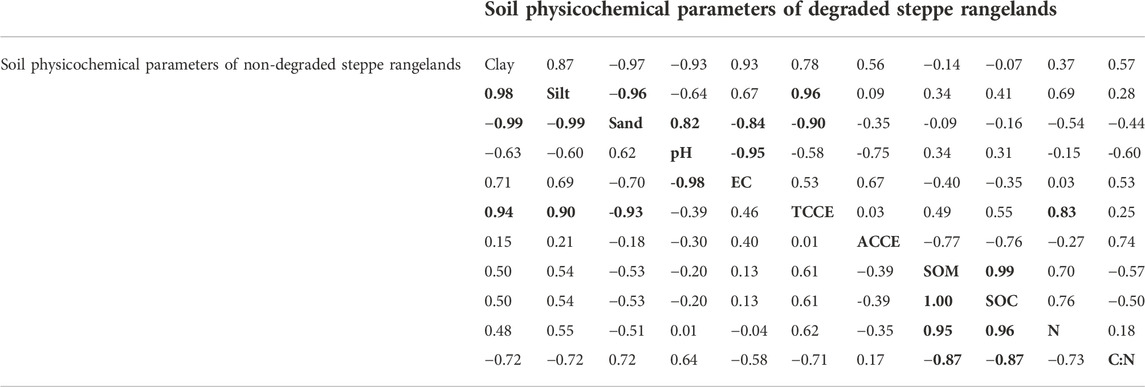
TABLE 3. Matrices of Pearson’s correlations between soil physicochemical parameters measured in degraded (above diagonal) and non-degraded (below diagonal) steppe rangelands in northeastern Algeria (see the subsection “2.3. Soil physicochemical analyses” for abbreviations of soil properties). Pearson’s correlation coefficients shown in boldface text are significant at p < 0.05.
The redundancy analysis (RDA) investigating the relationships between soil fertility indicators (i.e., organic carbon, total nitrogen, and C:N ratio) and the rest of soil physicochemical parameters in degraded and undegraded steppe rangelands totaled 75.11% of explained variance in the first two axes of the RDA triplot that accounted for 79.62 and 19.68% of the constrained inertia, respectively (Figure 6). Both total and active CaCO3 were the main edaphic variables explaining the change in soil fertility of degraded and undegraded steppes (Table 4). Total CaCO3 was positively correlated (r = 0.660, p = 0.019) on the first axis of RDA and influenced both organic carbon and total nitrogen in degraded steppes, whereas the active CaCO3 was negatively correlated (r = −0.627, p = 0.029) of the same axis and significantly affected the C:N ratio in undegraded steppes, especially is soil samples collected from the A2 horizon. Total nitrogen and SOC were associated with soil samples collected from the A1 horizon, mainly in degraded steppes (Figure 6). The contribution of the second axis of RDA (19.68%) was marginal as soil variables were not significantly correlated (Table 4), and there was no clear scheme in the distribution of these variables between soil horizons nor steppe degradation status (Figure 6).
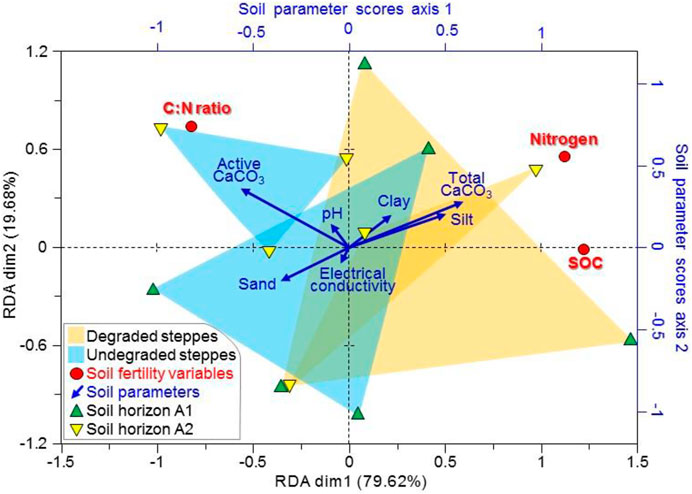
FIGURE 6. Tri-plot of redundancy analysis displaying relationships between soil physicochemical parameters and soil fertility indicators (i.e., organic carbon, total nitrogen, and C:N ratio) in soil horizons A1 and A2 for degraded and undegraded steppe rangelands of the Halfa grass (Macrochloa tenacissima) in northeastern Algeria.
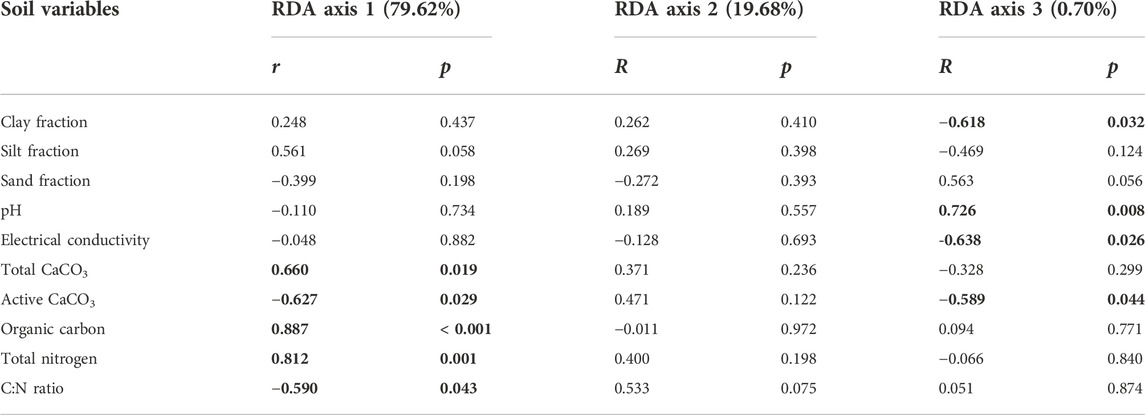
TABLE 4. Intraset correlation coefficients (r) and probability values (p) of soil physicochemical variables with the first three axes of RDA ordination. Percentages between brackets are constrained inertia of each axis. Significant correlations (p < 0.05) are indicated in boldface font.
This study investigated the influence of the short-term degradation of the steppe vegetation on some edaphic parameters in the Halfa (M. tenacissima) rangelands where grazing is practiced freely throughout the year. The results suggest that this land degradation can be corrected if appropriate management measures are implemented because the comparisons of edaphic parameters between degraded and undegraded rangelands of the three sampled steppes revealed a state of non-deterioration in soil conditions. Therefore, in the short term, the soil has been able to maintain its good state of fertility and functioning, which indicates that the restoration of the vegetation cover will allow the recovery of the initial state of the Halfa steppe. In the steppes of the high plains of Algeria, the Halfa, a Mediterranean perennial species, represents an iconic and emblematic species that stretches over vast areas. It plays the role of “keystone” within the steppe ecosystem in semi-arid and arid zones (Kadi-Hanifi, 1998; Jeddi and Chaieb, 2010; Merdas et al., 2021). Acting as a biological barrier against the advance of the desert through its highly developed root system, the species provides better soil fixation and protection against erosion (Moulay et al., 2012). In recent decades, the Halfa has undergone an advanced degradation triggered mainly by human activities, in particular overgrazing, which is the first driver for the disappearance of very large areas of Halfa and the extension of rainfed crops that further aggravated the effects of desertification (Aidoud and Touffet, 1996; Belala et al., 2018; Martínez-Valderrama et al., 2018). However, the decline in the vegetation cover of Halfa steppes in the short term, especially by grazing, does not seem to induce significant and immediate edaphic changes. According to the study by Aronson et al. (1995), the degradation of vital soil attributes, such as SOM or soil nutrients and fertility, can only be effectively detected after a period of about 10 years. But according to the study by Albaladejo et al. (1998), soil degradation was found to be somewhat faster; in fact, they estimated that after about 5 years, the reduction in plant cover can have a significant impact on soil characteristics through the decrease in SOM and soil fertility and even the deterioration of soil physical properties.
The results relating to the percentage of clay from sampling sites confirm that in degraded steppes, the level of clay was low compared to the dominance of coarse elements, i.e., sand. This particular state is due to the soil structure degradation at the level of clay–humic complexes and especially resulted from the sand encroachment and accumulation of coarse grains transported by the wind following the destitution of the soil and the reduction of vegetation cover, which represent the most efficient shield against wind and water erosions. Therefore, we can deduce that the presence of a good cover of Halfa favors the conservation of steppe soils by maintaining a balanced soil with high resilience to various forms of land degradation. The climatic conditions of the last decades, characterized by long periods of intense drought (Belala et al., 2018; Kouba et al., 2021), have been at the origin of the degradation of the vegetation cover of steppe formations dominated by M. tenacissima, Atriplex halimus, and Artemisia herba-alba, where large areas have been covered with thorny plants and/or species of low forage quality. With regard to soil productivity, the degradation of pastoral areas in Algeria from the 1980s to date shows a decrease in the indices of the productive value of pastures. In fact, plant cover represents 40% of the total pastoral area, while 3–4% of this area has been invaded by grazing areas; hence, the plant area declined to 20%, while the density of grazing livestock reached 12 heads per hectare which exceeds the carrying capacity (Macheroum and Kadik, 2015; Macheroum and Kadik, 2018). Moreover, among the most common and frequent forms of degradation that threaten the steppe rangelands of Algeria are desertification, invasion of sand dunes, plowing of steppe lands and creation of new agricultural perimeters, clearing of natural vegetation, depletion of surface and underground water, land salinization, soil fertility loss, fires, water, and wind erosion, and uncontrolled discharge of solid waste and wastewater (Figure 7).
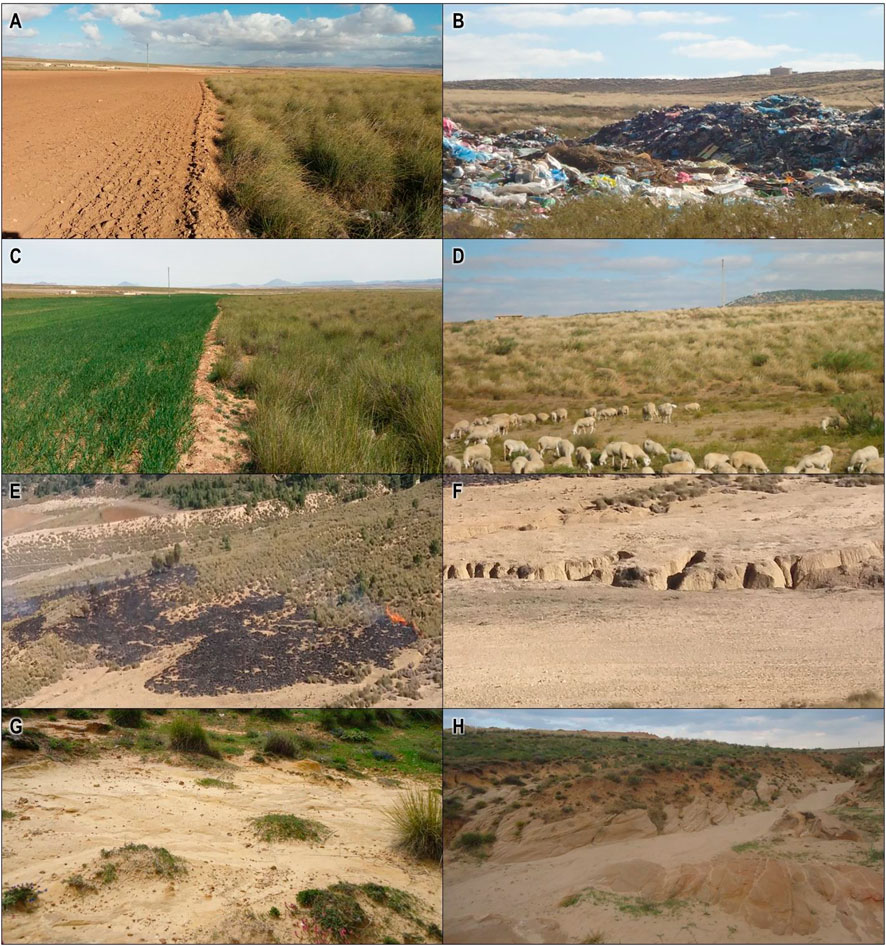
FIGURE 7. Photographs showing different forms of degradation and threat of Halfa (Macrochloa tenacissima syn. Stipa tenacissima) steppe rangelands in NE Algeria. (A) Plowing within extensive undegraded Halfa steppe, (B) uncontrolled discharge of solid wastes, (C) cultivation of rainfed cereal crops (Hordeum vulgare, Triticum durum, and Triticum aestivum), (D) overgrazing due to free grazing with an animal load exceeding the livestock carrying capacity, (E) rangeland fires, often associated with forest fire, (F) clearing of natural vegetation and water erosion, (G) sand encroachment and sand dune movement, and (H) Aeolian and water erosion.
Overall, our findings suggest that land degradation driven by short-term heavy grazing of vegetation did not cause a significant variation of soil physicochemical parameters between degraded and undegraded steppes and between the soil horizons A1 and A2. The particle size classification of soil textures shows a fairly contrasting composition. In degraded steppes, the level of clay was low compared to undegraded steppes. The comparison of soil textures shows an overall decrease in the fine grain fraction, and at the same time, the texture becomes coarser and sandy due to degradation of the plant cover by overgrazing and trampling, which promotes soil erosion, destruction of soil aggregates, transport particles, and sand encroachment (Aidoud et al., 1999; Slimani et al., 2010; Schmalz et al., 2013). The negative correlations observed between sands and fine grain particles (clay and silt) confirmed this, as is the case in degraded habitats (Douaoui et al., 2001; Aliat et al., 2016). Therefore, the presence of dense Halfa tufts in undegraded steppes (Figure 2A) promotes soil fixation against erosion (Hasnaoui and Bouazza, 2015). This kind of plant constitutes a real “nebka-trap” in windy open environments (Slimani, 1998; Bradai et al., 2015; Chenchouni et al., 2019; Chenchouni et al., 2022). The abundance of the fine grain fraction in the Halfa steppes of North Africa results from its origin, which belongs to the marl-limestone geological substratum (Kadi-Hanifi, 1998). It is noteworthy mentioning that the superficial horizons A1 and A2 of the same soil profile have high physicochemical homogeneity despite their morphological heterogeneity.
All soil samples studied had an alkaline pH according to the study by Baize (2018). In semi-arid lands, this parameter is considered among the most important indicators of soil changes (Li and Shao, 2006). In rangelands, it is strongly influenced by parental material (Rezaei and Gilkes, 2005) than the low biological activities of hot arid soils. Indeed, the studied soils are classified as strongly calcareous (Baize, 2018) because of the limestone origin of the region (Djebaili, 1984; Halitim, 1988), where the active fraction of CaCO3 varied between 17.5 ± 2.1 and 18.5 ± 0.3%. This high level of CaCO3 explains the soil alkalinity (Neffar et al., 2013); indeed the sampled soils were rich in active CaCO3 (> 10%). Soil pH generally encompasses the synthesis of several chemical interactions between edaphic variables (Douaoui et al., 2001). The alkalinity of the pH is also attributed to animal trampling and the alkalizing effect of sheep urine, which has a high pH of about 8.7 (Haynes and Williams, 1992). During the hydrolysis of urea of urine into NH4+ in the soil, the release of OH− causes an increase in pH and also enrichment of inorganic nitrogen in the soil (Ma et al., 2007). This explains the level of nitrogen in degraded steppes which was quite equal to N levels in undegraded steppes (mainly generated from SOM) and thus specifies the origin of nitrogen in each type of steppe. Indeed, there is a strong positive correlation between N and SOM (r = 0.95, p = 0.003) and C (r = 0.96, p = 0.003) in undegraded steppes (i.e., nitrogen has mainly an organic origin) and between N and total CaCO3 (r = 0.83, p = 0.039) in degraded steppes (i.e., nitrogen has mainly an inorganic origin). More generally, however, the measured concentrations of mineral nitrogen in all soil samples studied were low (Cortina and Maestre, 2005). These low levels of mineral nitrogen are attributed to competition for nitrogen consumption between microorganisms active in the rhizosphere of pastures and the roots of steppe plant species (Huntjens, 1971). Indeed, the contents of all the nutrients in the soil solution are generally low in steppes and, therefore, the ionic strength is low as reported in the study by Edmeades et al. (1985) in prairies. These observations between CaCO3 and SOC, N, and C:N ratio were confirmed by the RDA where the rate of mineralization (i.e., C:N ratio) was associated with alkalization (i.e., active CaCO3), whereas the low contents of SOC and nitrogen are considered a typical characteristic of the calcareous soils (i.e., rich in total CaCO3) in semiarid steppes of N Africa where the haplic calcisols dominate. According to the study by Duchaufour (1997), the soil is considered rich in SOM when its level is higher than 2%, and according to the assessments of Djebaili (1984) this rate does not exceed 3% in steppe soils. Accordingly, the studied soils are moderately rich in SOM, except for the A2 horizon of undegraded Halfa steppes which was the poorest in SOM (1.42 ± 0.22%). However, according to the study by Kadi-Hanifi (1998), the studied soils can be classified as low in SOM. The statistical analyses showed that there is no significant difference in SOM and SOC content when changing from an undegraded steppe to a degraded steppe. The relatively high levels of SOM and SOC in the undegraded steppes are due to Halfa tufts, which form small mounds and contribute actively in improving soil properties by providing SOM and intercepting and then fixing soil fine grain elements (Aidoud et al., 1999). This explains the richness with SOM of the surface horizon of the soil. While the traces of SOM in the degraded steppes are justified by the importance of the necromass (Figure 2C) released from Halfa tufts after trampling and/or grazing by livestock in the form of plant litter and animal excreta.
Often an alkaline soil pH indicates the presence of salinity and correlates with electrical conductivity (Mehalaine and Chenchouni, 2020). But in our case, the EC correlates negatively with pH and sand and positively with clay, while the increase in pH value and level of sand is accompanied by a proportional decrease in salinity and clay fraction. This may be related to the nature of the salts (Chenchouni, 2017) and the moisture level of the land (Mihi et al., 2019). The comparison of the electrical conductivity of sampled soils in this study with the classification proposed in the study by Mathieu and Pieltain (2003) shows that the surface horizon (A1) of the soil in degraded steppes is non-saline, whereas the rest of the soil samples were slightly salty. The low EC of the A1 horizon is due to the coarse grain texture which induces an influence that makes grains unable to retain cations because of its permeability and favors it to accumulate in the A2 horizon, which was more saline than in A1. Although the EC was low, the presence of slight salinity in the undegraded steppes can be explained by the high level of clay which makes the soil less or impermeable and favors the stagnation of water laden with cations (Chenchouni, 2009, 2017), which slightly increases the salinity once the salts accumulate on the surface after water evaporation or by the capillary rise of saline solution to the surface (Osman, 2018). This indicates that EC does not always imply structural degradation of the edaphic environment (Douaoui et al., 2001).
This study revealed strong positive correlations between the fine fraction (clay and silt) and SOM (Slimani, 1998), total limestone (Mbagwu and Bazzoffi, 1998), nitrogen, and low salinity (electrical conductivity), which seem to be indicators of the improvement of the structural stability of the soil (Douaoui et al., 2001). The negative correlations observed between these same variables with the coarse fractions (Slimani, 1998) and the alkaline pH can be considered indicators of processes favoring the structural degradation of the soil (Douaoui et al., 2001). The strong negative correlation between the level of SOM and the C:N ratio indicates the rapidity of SOM mineralization, which is a characteristic of arid and semiarid North African steppes (Djebaili, 1984; Boudjabi and Chenchouni, 2022).
The results of this study showed that the short-term degradation of the steppe vegetation cover by grazing did not lead to a large significant difference in the soil chemical parameters between the degraded and undegraded Halfa steppes because short-term grazing has impact on the biotic order, which causes the destruction of perennial species (Aidoud and Touffet, 1996). Therefore, significant changes in the soil are considered the final stage in the degradation of the ecosystem and a threshold of irreversibility in the long-term decline of natural habitats (Slimani, 1998). In this sense, several studies have shown that long-term grazing negatively affects the vegetation, soil physicochemical properties, and ecosystem services of grasslands and steppes (Zeng et al., 2015; Dlamini et al., 2016; Pulido et al., 2017; Zhang et al., 2017; Gao et al., 2018). But, on the other hand, the implementation of appropriate exclosure land management systems, such as grazing exclusion, drives significant improvements in both soil and vegetation properties in degraded rangelands (Jeddi and Chaieb, 2010; Linstädter and Baumann, 2013; Mekuria and Aynekulu, 2013; Kouba et al., 2021). In addition, the rehabilitation of arid and semiarid steppe rangelands using plantations “plant nurses” has proven to efficiently trigger increases in soil fertility, plant diversity, and vegetation cover (Neffar et al., 2013, 2015, 2018). Also, Cheng et al. (2016) showed that the exclusion of pastures significantly increased biodiversity, litter, and soil fertility (total nitrogen and SOC). But, they also found that long-term grazing exclusion had a negative effect on the diversity and abundance of soil bacteria. The comparison of soil physicochemical parameters and the floristic richness between grazed and short-term grazing exclusion in arid degraded steppes showed significant variations in coarse elements, sand, and biodiversity (Amghar et al., 2012; Kouba et al., 2021). But, there was no variation in soil chemical characteristics. The results of the study by Ye et al. (2016) showed that the effects of grazing during 18 months were not important on the functioning (i.e., chemical and biological parameters) of the soil. Shrestha and Stahl (2008) also observed no change in SOC. Moreover, by studying the effect of grazing on the soil, Dormaar and Willms (1998) observed similar results to our study, in which SOC contents did not vary significantly between grazed meadows and non-grazed lands, with very little change in the C:N ratio associated with light grazing. But, long-term heavy grazing pressures induced a significant decrease in SOC levels, while increasing pH, CaCl2, and total nitrogen. High grazing pressure reduces soil fertility by significantly inhibiting soil respiration rates (Chen et al., 2017). Therefore, long-term grazing causes slow and continuous changes in both vegetation and soil, inducing persistent land degradation of the ecosystem (Porensky et al., 2016). In the steppes of West Algeria, Aidoud et al. (2011) observed a decrease in the level of clay of 57% and in SOM of 61% in steppes grazed for 30 years, while the decrease was not significant for the two soil variables in steppes with grazing exclusion. The long-term degradation of the Halfa steppe was accompanied by severe deterioration of edaphic properties.
The degradation of vegetation by livestock grazing in the short term (up to 2 years) did not cause significant variations in soil physicochemical properties in the different soil horizons of the semi-arid steppes of Halfa. This demonstrated that the degradation of vegetation by grazing has not affected the edaphic environment, and thus this short-term degradation can be corrected by urgent land restoration actions. The soils analyzed in the Halfa steppes of NE Algeria are characterized by moderately fine textures in the undegraded steppes and coarse textures in the degraded steppes. The high accumulations of CaCO3 in the soils in these areas are linked to the type of substrate. The low contents of SOM, carbon, and nitrogen resulted from the rate of mineralization, which is faster in alkaline and slightly salty habitats, especially under hot semi-arid conditions. North African steppe rangelands are prone to land degradation because of their high sensitivity to desertification, severe drought events, erosion, and livestock overgrazing. Given the current ecological situation of steppe ecosystems in semi-arid zones, it is necessary to promote a homogeneous steppe management program with the participation of local populations in the long and medium term. In order to solve the problems of land and steppe vegetation degradation and accordingly avoid soil degradation in the future, the actions of land management to be implemented in the near future in degraded and/or vulnerable steppes are, in particular, 1) rehabilitation by planting degraded areas and enclosure of rangelands that are too affected, sensitive, and/or very degraded in order to stimulate natural regeneration, 2) adoption of a rotational grazing system that considers short periods of free grazing alternated with grazing exclusion in order to sustain the productivity of the rangeland, and 3) consideration of livestock carrying capacity of the grazed rangeland in the grazing management in order to prevent overgrazing and soil trampling (Chenchouni and Neffar, 2022).
The datasets used and/or analyzed in this study are available from the corresponding author upon reasonable request.
AM: conceptualization, methodology, investigation, and writing—original draft. HC: conceptualization, formal analysis, visualization, validation, writing—original draft, and writing—review and editing.
The authors declare that the research was conducted in the absence of any commercial or financial relationships that could be construed as a potential conflict of interest.
All claims expressed in this article are solely those of the authors and do not necessarily represent those of their affiliated organizations, or those of the publisher, the editors, and the reviewers. Any product that may be evaluated in this article, or claim that may be made by its manufacturer, is not guaranteed or endorsed by the publisher.
The Supplementary Material for this article can be found online at: https://www.frontiersin.org/articles/10.3389/fenvs.2022.846045/full#supplementary-material
Aidoud, A., Slimani, H., Aidoud-Lounis, F., and Touffet, J. (1999). Changements édaphiques le long d'un gradient d'intensité de pâturage dans une steppe d'Algérie. Ecol. Mediterr. 25 (2), 163–171. doi:10.3406/ecmed.1999.1881
Aidoud, A., Slimani, H., and Rozé, F. (2011). La surveillance à long terme des écosystèmes arides méditerranéens : Quels enseignements pour la restauration ? Cas d'une steppe d'Alfa (Stipa tenacissima L.) en Algérie. Ecol. Mediterr. 37 (2), 17–32. doi:10.3406/ecmed.2011.1335
Aidoud, A., and Touffet, J. (1996). La régression de l’Alfa (Stipa tenacissima L.), graminée pérenne, un indicateur de désertification des steppes algériennes. Sécheresse 7 (3), 187–193.
Albaladejo, J., Martinez-Mena, M., Roldan, A., and Castillo, V. (1998). Soil degradation and desertification induced by vegetation removal in a semiarid environment. Soil Use Manag. 14, 1–5. doi:10.1111/j.1475-2743.1998.tb00602.x
Aliat, T., Kaabeche, M., Khomri, H., Nouri, L., Neffar, S., and Chenchouni, H. (2016). A pedological characterisation of some inland wetlands and Ramsar sites in Algeria. Land Degrad. Dev. 27 (3), 693–705. doi:10.1002/ldr.2467
Amghar, F., Forey, E., Margerie, P., Langlois, E., Brouri, L., and Kadi-Hanifi, H. (2012). Grazing exclosure and plantation: A synchronic study of two restoration techniques improving plant community and soil properties in arid degraded steppes (Algeria). Rev. Écol. (Terre Vie) 67, 257–269.
Arar, A., and Chenchouni, H. (2014). A "simple" geomatics-based approach for assessing water erosion hazard at montane areas. Arab. J. Geosci. 7 (1), 1–12. doi:10.1007/s12517-012-0782-4
Aronson, J., Floret, C., Le Floc’h, E., Ovalle, C., and Pontanier, R. (1995). “Restauration et réhabilitation des écosystèmes dégradés en zones arides et semi-arides. Le vocabulaire et les concepts,” in L’homme peut-il refaire ce qu’il a défait ? Editors R. Pontanier, A. M’hiri, J. Aronson, N. Akrimi, and E. Le Floc’h (Paris: J. Libbey Eurotext), 11–29.
Baize, D. (2018). Guide des analyses en pédologie: 3e édition revue et augmentée. Paris: Editions Quae.
Bansal, S., and Sheley, R. L. (2016). Annual grass invasion in sagebrush steppe: The relative importance of climate, soil properties and biotic interactions. Oecologia 181 (2), 543–557. doi:10.1007/s00442-016-3583-8
Baranian Kabir, E., Bashari, H., Mosaddeghi, M. R., and Bassiri, M. (2017). Soil aggregate stability and organic matter as affected by land-use change in central Iran. Archives Agron. Soil Sci. 63 (13), 1823–1837. doi:10.1080/03650340.2017.1308492
Belala, F., Hirche, A., Muller, S. D., Tourki, M., Salamani, M., Grandi, M., et al. (2018). Rainfall patterns of Algerian steppes and the impacts on natural vegetation in the 20th century. J. Arid. Land 10 (4), 561–573. doi:10.1007/s40333-018-0095-x
Benabderrahmane, M. C., and Chenchouni, H. (2010). Assessing environmental sensitivity areas to desertification in Eastern Algeria using Mediterranean desertification and land use “MEDALUS” model. Swes 1 (1), 5–10. doi:10.5383/swes.01.01.002.5
Bezzalla, A., Houhamdi, M., and Chenchouni, H. (2019). “Vegetation analysis of Chott Tinsilt and Sebkhet Ezzemoul (two Ramsar sites in Algeria) in relation to soil proprieties,” in Exploring the nexus of geoecology, geography, geoarcheology and geotourism. Editors H. Chenchouni, E. Errami, F. Rocha, and L. Sabato (Cham: Springer), 39–42. doi:10.1007/978-3-030-01683-8_8
Bouaroudj, S., Menad, A., Bounamous, A., Ali-Khodja, H., Gherib, A., Weigel, D. E., et al. (2019). Assessment of water quality at the largest dam in Algeria (Beni Haroun Dam) and effects of irrigation on soil characteristics of agricultural lands. Chemosphere 219, 76–88. doi:10.1016/j.chemosphere.2018.11.193
Boudjabi, S., and Chenchouni, H. (2021). On the sustainability of land applications of sewage sludge: how to apply the sewage biosolid in order to improve soil fertility and increase crop yield?. Chemosphere 282, 131122. doi:10.1016/j.chemosphere.2021.131122
Boudjabi, S., and Chenchouni, H. (2022). Soil fertility indicators and soil stoichiometry in semi-arid steppe rangelands. CATENA 210 (3), 105910. doi:10.1016/j.catena.2021.105910
Bradai, L., Bouallala, M. H., Bouziane, N. F., Zaoui, S., Neffar, S., and Chenchouni, H. (2015). An appraisal of eremophyte diversity and plant traits in a rocky desert of the Sahara. Folia Geobot. 50 (3), 239–252. doi:10.1007/s12224-015-9218-8
Chen, W., Zheng, X., Wolf, B., Yao, Z., Liu, C., Butterbach-Bahl, K., et al. (2019). Long-term grazing effects on soil-atmosphere exchanges of CO2, CH4 and N2O at different grasslands in inner Mongolia: A soil core study. Ecol. Indic. 105, 316–328. doi:10.1016/j.ecolind.2017.09.035
Chenchouni, H. (2009). “Place des argiles dans la caractérisation écopédologique du Chott de Djendli (Batna, Algérie) et mise en évidence de la relation salinité–répartition des halophytes,” in Proceedings of the 3rd Maghrebin Symposium on Clays ‘“SMA”, Algérie, November 2009, 23–25.
Chenchouni, H. (2010). “Drought-induced mass mortality of Atlas Cedar forest (Cedrus atlantica) in Algeria,” in The international forestry Review, 33th IUFRO world congress. Editors J. A. Parrota, and M. A. Carr (Seoul, Korea. 23–28 August 2010.
Chenchouni, H. (2017). Edaphic factors controlling the distribution of inland halophytes in an ephemeral salt lake "Sabkha ecosystem" at North African semi-arid lands. Sci. Total Environ. 575, 660–671. doi:10.1016/j.scitotenv.2016.09.071
Chenchouni, H., Errami, E., Rocha, F., and Sabato, L. (2019). Exploring the nexus of geoecology, geography, geoarcheology and geotourism: Advances and applications for sustainable development in environmental sciences and agroforestry research. Cham: Springer. doi:10.1007/978-3-030-01683-8
Chenchouni, H., Chaminé, H. I., Khan, M. F., Merkel, B. J., Zhang, Z., Li, P., et al. (Editors) (2022). New prospects in environmental geosciences and hydrogeosciences (Cham: Springer). doi:10.1007/978-3-030-72543-3
Chenchouni, H., and Neffar, S. (2022). Soil organic carbon stock in arid and semi-arid steppe rangelands of North Africa. CATENA 212 (1), 106004. doi:10.1016/j.catena.2021.106004
Cheng, J., Jing, G., Wei, L., and Jing, Z. (2016). Long-term grazing exclusion effects on vegetation characteristics, soil properties and bacterial communities in the semi-arid grasslands of China. Ecol. Eng. 97, 170–178. doi:10.1016/j.ecoleng.2016.09.003
Cortina, J., and Maestre, F. T. (2005). “Plant effects on soils in drylands: Implications for community dynamics and ecosystem restoration,” in Tree species effects on soils: Implications for global change. Editors D. Binkley, and O. Menyailo (Dordrecht: Springer), 85–118. doi:10.1007/1-4020-3447-4_6
Dalila, D., and Slimane, S. (2008). La désertification dans les steppes algériennes : Causes, impacts et actions de lutte. Vertigo 8 (1), 15. doi:10.4000/vertigo.5375
Djebaili, S. (1984). Steppe algérienne, phytosociologie et écologie. Recherche phytosociologique et écologique sur la végétation des hautes plaines steppiques et de l'Atlas saharien. Algiers: Office des publications universitaires.
Dlamini, P., Chivenge, P., and Chaplot, V. (2016). Overgrazing decreases soil organic carbon stocks the most under dry climates and low soil pH: A meta-analysis shows. Agric. Ecosyst. Environ. 221, 258–269. doi:10.1016/j.agee.2016.01.026
Dormaar, J. F., and Willms, W. D. (1998). Effect of forty-four years of grazing on fescue grassland soils. J. Range Manag. 51 (1), 122–126. doi:10.2307/4003574
Douaoui, A., BenboualI, E. H., and Gaouar, A. (2001). Les facteurs intrinsèques de dégradation de la structure de surface des sols du bas Cheliff. Ann. Inst. Natl. Agron. – EI-Harrach 22 (1–2), 27–47.
Dragović, N., and Vulević, T. (2020). “Soil degradation processes, causes, and assessment approaches,” in Life on land. Encyclopedia of the UN sustainable development goals. Editors W. Leal Filho, A. Azul, L. Brandli, A. Lange Salvia, and T. Wall (Cham: Springer). doi:10.1007/978-3-319-71065-5_86-1
Duchaufour, P. (1997). Sol, végétation, environnement. 5th Edition. Paris: Masson, 291.Abrégé de pédologie
Edmeades, D. C., Wheeler, D. M., and Clinton, O. E. (1985). The chemical composition and ionic strength of soil solutions from New Zealand topsoils. Soil Res. 23 (2), 151–165. doi:10.1071/sr9850151
Fialho, R. C., and Zinn, Y. L. (2014). Changes in soil organic carbon undereucalyptusplantations in Brazil: A comparative analysis. Land Degrad. Dev. 25 (5), 428–437. doi:10.1002/ldr.2158
Gao, X., Thomas, B. W., Beck, R., Thompson, D. J., Zhao, M., Willms, W. D., et al. (2018). Long-term grazing alters soil trace gas fluxes from grasslands in the foothills of the rocky mountains, Canada. Land Degrad. Dev. 29 (2), 292–302. doi:10.1002/ldr.2664
Garcia, C., Nannipieri, P., and Hernandez, T. (2018). “The future of soil carbon,” in The future of soil carbon: Its conservation and formation. Editors C. Garcia, P. Nannipieri, and T. Hernandez (Academic Press), 239–267. doi:10.1016/b978-0-12-811687-6.00009-2
Hadeid, M. (2006). Les mutations spatiales et sociales d’un espace à caractère steppique. Le cas des hautes plaines sud-oranaises (Algérie). Doctoral thesis. Besançon, France: Univ. Franche-Comté.
Hamel, M. (2018). The Impact of climate change on erosion and food security in the extreme west of Algeria (Tafna Basin). Master dissertation. Tlemcen, Algeria: Pan African university.
Hasnaoui, O., and Bouazza, M. (2015). Indicateurs de Degradation des Bio-Ressources Naturelles de l'Algerie Occidentale : Cas de la Steppe de la Wilaya de Saida = Indicators of Degradation of Natural Bio-Resources of Western Algeria : Case of Steppe of Saida Province. Algerian J. Arid Environ. 5 (1), 63–75. doi:10.12816/0045908
Haynes, R. J., and Williams, P. H. (1992). Changes in soil solution composition and pH in urine-affected areas of pasture. J. Soil Sci. 43 (2), 323–334. doi:10.1111/j.1365-2389.1992.tb00140.x
HCDS-BNEDER (2007). Fiche d’identification des potentialités culturales de la commune d’El Houidjbet. Algiers: Bureau National d’Études pour le Développement Rural & High Commission for the Development of Steppe (HCDS).
Huntjens, J. L. M. (1971). The influence of living plants on mineralization and immobilization of nitrogen. Plant Soil 35 (1–3), 77–94. doi:10.1007/bf01372634
Jeddi, K., and Chaieb, M. (2010). Changes in soil properties and vegetation following livestock grazing exclusion in degraded arid environments of South Tunisia. Flora - Morphol. Distribution, Funct. Ecol. Plants 205 (3), 184–189. doi:10.1016/j.flora.2009.03.002
Joosten, H. (2015). “Current soil carbon loss and land degradation globally: Where are the hotspots and why there?,”. Soil carbon: Science, management and policy for multiple benefits. Editors S. A. Banwart, E. Noellemeyer, and E. Milne (UK: CAB International), 71, 224–234. doi:10.1079/9781780645322.0224
Kadi-Hanifi, H. (1998). L’Alfa en algérie: Syntaxonomie, relations milieu-végétation, dynamique et perspectives d’avenir. Algeria: Doctoral thesis, Univ. USTHB.
Kouba, Y., Merdas, S., Mostephaoui, T., Saadali, B., and Chenchouni, H. (2021). Plant community composition and structure under short-term grazing exclusion in steppic arid rangelands. Ecol. Indic. 120, 106910. doi:10.1016/j.ecolind.2020.106910
Le Houérou, H. N. (2001). Biogeography of the arid steppeland north of the Sahara. J. Arid Environ. 48 (2), 103–128. doi:10.1006/jare.2000.0679
Le Houérou, H. N. (2009). “Long-term dynamics in arid-land vegetation and ecosystems of North Africa,” in Arid land ecosystems: Volume 2, structure, functioning and management. Editors D. W. Goodall, R. A. Perry, and K. M. W. Howes (Cambridge University Press), 357–384.
Li, Y. Y., and Shao, M. A. (2006). Change of soil physical properties under long-term natural vegetation restoration in the Loess Plateau of China. J. Arid Environ. 64 (1), 77–96. doi:10.1016/j.jaridenv.2005.04.005
Linstädter, A., and Baumann, G. (2013). Abiotic and biotic recovery pathways of arid rangelands: Lessons from the high atlas mountains, Morocco. Catena 103, 3–15. doi:10.1016/j.catena.2012.02.002
Liu, W., Sun, S., Zhang, C., Lv, S., and Dong, Q. (2020). Linking plant spatial aggregation with reproductive traits and near-source seed dispersal: Ecological adaptation to heavy grazing. J. Plant Ecol. 13 (4), 489–498. doi:10.1093/jpe/rtaa036
Ma, X., Wang, S., Jiang, G., Haneklaus, S., Schnug, E., and Nyren, P. (2007). Short-term effect of targeted placements of sheep excrement on grassland in inner Mongolia on soil and plant parameters. Commun. Soil Sci. Plant Analysis 38 (11–12), 1589–1604. doi:10.1080/00103620701378516
Macheroum, A., and Kadik, L. (2015). Étude de l’étude actuel de la végétation du Nord de la wilaya de Tébessa sur le plan phytoécologie et pastoral. France: Edilivre, Saint-Denis.
Macheroum, A., and Kadik, L. (2018). Évaluation des ressources pastorales et de la biodiversité floristique du nord de Tébessa. Biocénoses 9 (1), 42–63.
Martínez-Valderrama, J., Ibáñez, J., Del Barrio, G., Alcalá, F. J., Sanjuán, M. E., Ruiz, A., et al. (2018). Doomed to collapse: Why Algerian steppe rangelands are overgrazed and some lessons to help land-use transitions. Sci. Total Environ. 613-614, 1489–1497. doi:10.1016/j.scitotenv.2017.07.058
Mathieu, C., and Pieltain, F. (2003). Analyse chimique des sols: Méthodes choisies. Paris: Tec & Doc.
Mbagwu, J. S. C., and Bazzoffi, P. (1998). Soil characteristics related to resistance of breakdown of dry soil aggregates by water-drops. Soil Tillage Res. 45 (1–2), 133–145. doi:10.1016/S0933-3630(96)00133-X
Mehalaine, S., and Chenchouni, H. (2020). Plants of the same place do not have the same metabolic pace: Soil properties affect differently essential oil yields of plants growing wild in semiarid mediterranean lands. Arab. J. Geosci. 13 (23), 1263. doi:10.1007/s12517-020-06219-4
Mehalaine, S., and Chenchouni, H. (2022). “Effect of edaphic factors on essential oil production in wild plants growing under semiarid Mediterranean conditions,” in New prospects in environmental geosciences and hydrogeosciences. Editors H. Chenchouni, H. I. Chaminé, M. F. Khan, B. J. Merkel, Z. Zhang, P. Liet al. (Cham: Springer), 151–156. doi:10.1007/978-3-030-72543-3_34
Mekuria, W., and Aynekulu, E. (2013). Exclosure land management for restoration of the soils in degraded communal grazing lands in northern Ethiopia. Land Degrad. Dev. 24 (6), 528–538. doi:10.1002/ldr.1146
Merdas, S., Kouba, Y., Mostephaoui, T., Farhi, Y., and Chenchouni, H. (2021). Livestock grazing-induced large-scale biotic homogenization in arid Mediterranean steppe rangelands. Land Degrad. Development/Authorea 32, 5099–5107. doi:10.22541/au.161494226.60674414
Mihi, A., Tarai, N., and Chenchouni, H. (2019). Can palm date plantations and oasification be used as a proxy to fight sustainably against desertification and sand encroachment in hot drylands? Ecol. Indic. 105, 365–375. doi:10.1016/j.ecolind.2017.11.027
Moulay, A., Benabdeli, K., and Morsli, A. (2012). Quel avenir pour la steppe à Alfa dans le sud-ouest Algérien. Forêt Méditerranéenne 33, 277–286. Available at: https://www.foret-mediterraneenne.org/fr/catalogue/id-1723.
Neffar, S., Chenchouni, H., Beddiar, A., and Redjel, N. (2013). Rehabilitation of degraded rangeland in drylands by prickly pear (Opuntia ficus-indica L.) plantations: Effect on soil and spontaneous vegetation. Ecol. Balk. 5 (2), 63–83.
Neffar, S., Beddiar, A., and Chenchoun, H. (2015). Effects of soil chemical properties and seasonality on mycorrhizal status of prickly pear (Opuntia ficus-indica) planted in hot arid steppe rangelands. Sains Malays. 44, 671–680. doi:10.17576/jsm-2015-4405-05
Neffar, S., Beddiar, A., Menasria, T., and Chenchouni, H. (2022). Planting prickly pears as a sustainable alternative and restoration tool for rehabilitating degraded soils in dry steppe rangelands. Arab. J. Geosci. 15 (3), 287. doi:10.1007/s12517-022-09579-1
Neffar, S., Menasria, T., and Chenchouni, H. (2018). Diversity and functional traits of spontaneous plant species in Algerian rangelands rehabilitated with prickly pear (Opuntia ficusindica L.) plantations. Turk J. Bot. 42, 448–461. doi:10.3906/bot-1801-39
Negm, A., Bouderbala, A., Chenchouni, H., and Barcelo, D. (2020). Water resources in Algeria - Part I: Assessment of surface and groundwater. Switzerland: Springer Nature. doi:10.1007/978-3-030-57895-4
Porensky, L. M., Mueller, K. E., Augustine, D. J., and Derner, J. D. (2016). Thresholds and gradients in a semi-arid grassland: Long-term grazing treatments induce slow, continuous and reversible vegetation change. J. Appl. Ecol. 53 (4), 1013–1022. doi:10.1111/1365-2664.12630
Pulido, M., Schnabel, S., Lavado Contador, J. F. L., Lozano-Parra, J., Gómez-Gutiérrez, Á., Brevik, E. C., et al. (2017). Reduction of the frequency of herbaceous roots as an effect of soil compaction induced by heavy grazing in rangelands of SW Spain. Catena 158, 381–389. doi:10.1016/j.catena.2017.07.019
R Core Team (2020). R: A language and environment for statistical computing. Vienna, Austria: R Foundation for Statistical Computing. Available at: www.R-project.org.
Rezaei, S. A., and Gilkes, R. J. (2005). The effects of landscape attributes and plant community on soil chemical properties in rangelands. Geoderma 125 (1–2), 167–176. doi:10.1016/j.geoderma.2004.07.010
Schmalz, H. J., Taylor, R. V., Johnson, T. N., Kennedy, P. L., DeBano, S. J., Newingham, B. A., et al. (2013). Soil morphologic properties and cattle stocking rate affect dynamic soil properties. Rangel. Ecol. Manag. 66 (4), 445–453. doi:10.2111/rem-d-12-00040.1
Shrestha, G., and Stahl, P. D. (2008). Carbon accumulation and storage in semi-arid sagebrush steppe: Effects of long-term grazing exclusion. Agric. Ecosyst. Environ. 125 (1–4), 173–181. doi:10.1016/j.agee.2007.12.007
Singh, A. K., Zhu, X., Chen, C., Wu, J., Yang, B., Zakari, S., et al. (2020). The role of glomalin in mitigation of multiple soil degradation problems. Crit. Rev. Environ. Sci. Technol. 52, 1604–1638. doi:10.1080/10643389.2020.1862561
Slimani, H., Aidoud, A., and Rozé, F. (2010). 30 Years of protection and monitoring of a steppic rangeland undergoing desertification. J. Arid Environ. 74 (6), 685–691. doi:10.1016/j.jaridenv.2009.10.015
Slimani, H. (1998). Effet du pâturage sur la végétation et le sol et désertification. Cas de la steppe d’Alfa (Stipa tenacissima L.) de Rogassa des Hautes Plaines occidentales algériennes. Algiers: Magister dissertation, USTHB.
Smith, P., Calvin, K., Nkem, J., Campbell, D., Cherubini, F., Grassi, G., et al. (2020). Which practices co-deliver food security, climate change mitigation and adaptation, and combat land degradation and desertification? Glob. Change Biol. 26 (3), 1532–1575. doi:10.1111/gcb.14878
Snyman, H. A. (2005). Rangeland degradation in a semi-arid south Africa-I: Influence on seasonal root distribution, root/shoot ratios and water-use efficiency. J. Arid Environ. 60 (3), 457–481. doi:10.1016/j.jaridenv.2004.06.006
Stuart Chapin III, F. S., McFarland, J., David McGuire, A. D., Euskirchen, E. S., Ruess, R. W., and Kielland, K. (2009). The changing global carbon cycle: Linking plant-soil carbon dynamics to global consequences. J. Ecol. 97 (5), 840–850. doi:10.1111/j.1365-2745.2009.01529.x
Ye, L., Lata, J. C., Masse, D., Nacro, H. B., and Barot, S. (2016). Effets du pâturage sur la biomasse herbacée et sur des paramètres chimiques et biologiques des sols dans une savane arbustive au Burkina Faso. Int. J. Bio. Chem. Sci. 10 (6), 2539–2554. doi:10.4314/ijbcs.v10i6.11
Yong-Zhong, S., Yu-Lin, L., Jian-Yuan, C., and Wen-Zhi, Z. (2005). Influences of continuous grazing and livestock exclusion on soil properties in a degraded sandy grassland, Inner Mongolia, northern China. CATENA 59 (3), 267–278. doi:10.1016/j.catena.2004.09.001
Zeng, C., Wu, J., and Zhang, X. (2015). Effects of grazing on above- vs. below-ground biomass allocation of alpine grasslands on the Northern Tibetan Plateau. PloS One 10 (8), e0135173. doi:10.1371/journal.pone.0135173
Keywords: land degradation, Mediterranean steppes, rangeland soil, soil fertility, soil organic matter, livestock grazing, haplic calcisols, drylands
Citation: Macheroum A and Chenchouni H (2022) Short-term land degradation driven by livestock grazing does not affect soil properties in semiarid steppe rangelands. Front. Environ. Sci. 10:846045. doi: 10.3389/fenvs.2022.846045
Received: 30 December 2021; Accepted: 28 July 2022;
Published: 07 September 2022.
Edited by:
Jifeng Deng, Shenyang Agricultural University, ChinaReviewed by:
Jagdish Chander Dagar, Indian Council of Agricultural Research (ICAR), IndiaCopyright © 2022 Macheroum and Chenchouni. This is an open-access article distributed under the terms of the Creative Commons Attribution License (CC BY). The use, distribution or reproduction in other forums is permitted, provided the original author(s) and the copyright owner(s) are credited and that the original publication in this journal is cited, in accordance with accepted academic practice. No use, distribution or reproduction is permitted which does not comply with these terms.
*Correspondence: Haroun Chenchouni, Y2hlbmNob3VuaUBnbWFpbC5jb20=
†ORCID: Amale Macheroum, orcid.org/0000-0002-9095-3731; Haroun Chenchouni, orcid.org/0000-0001-9077-2706
Disclaimer: All claims expressed in this article are solely those of the authors and do not necessarily represent those of their affiliated organizations, or those of the publisher, the editors and the reviewers. Any product that may be evaluated in this article or claim that may be made by its manufacturer is not guaranteed or endorsed by the publisher.
Research integrity at Frontiers

Learn more about the work of our research integrity team to safeguard the quality of each article we publish.